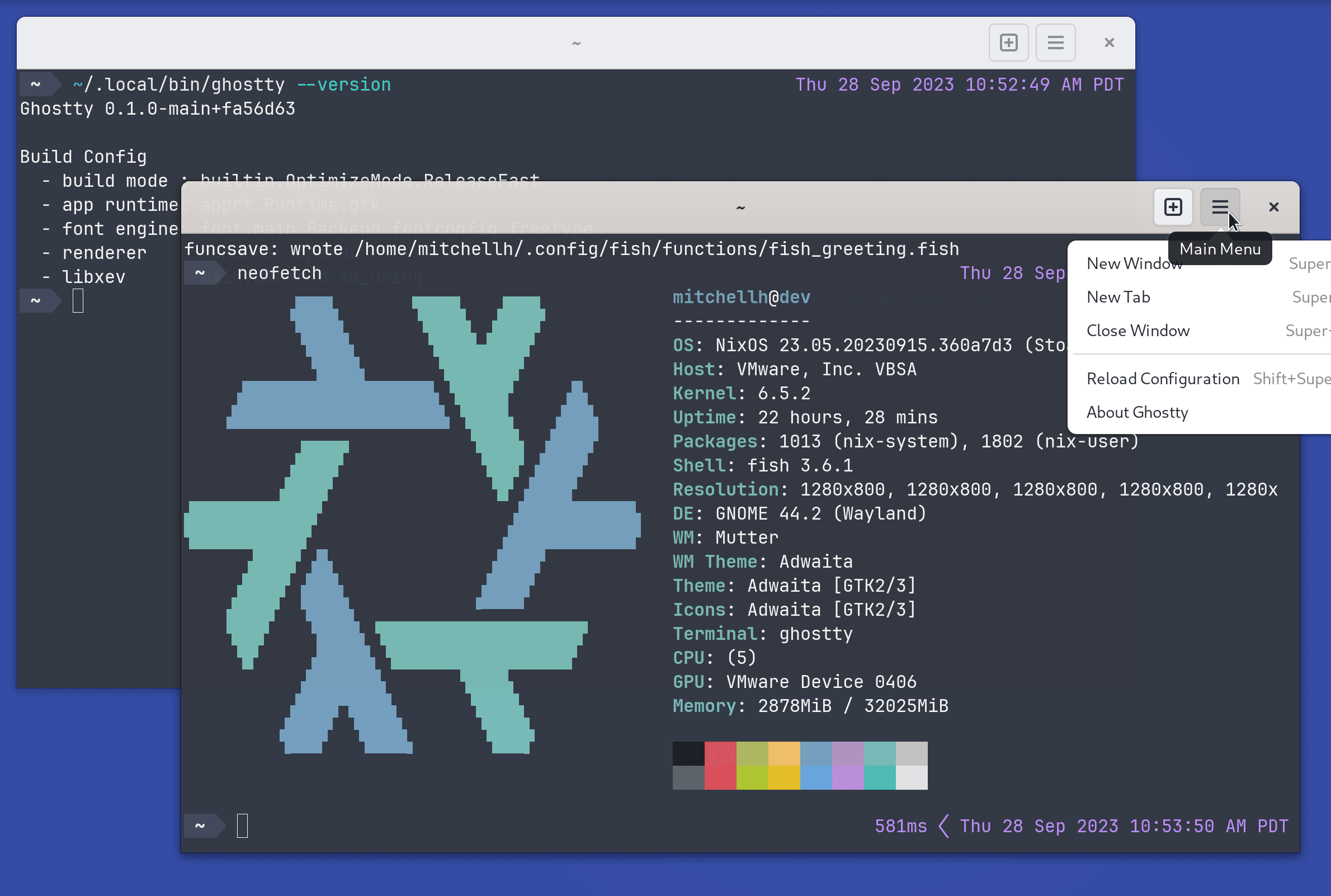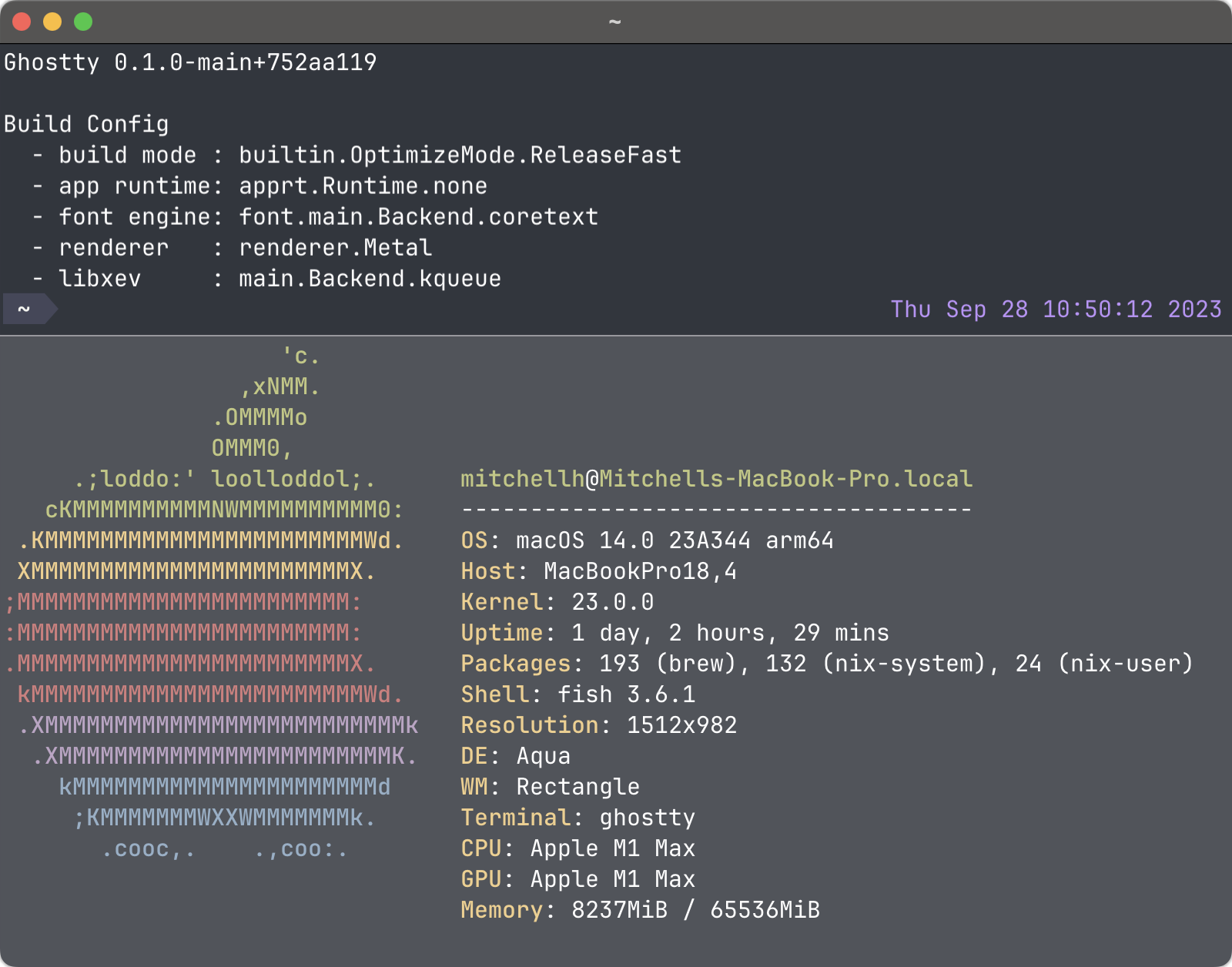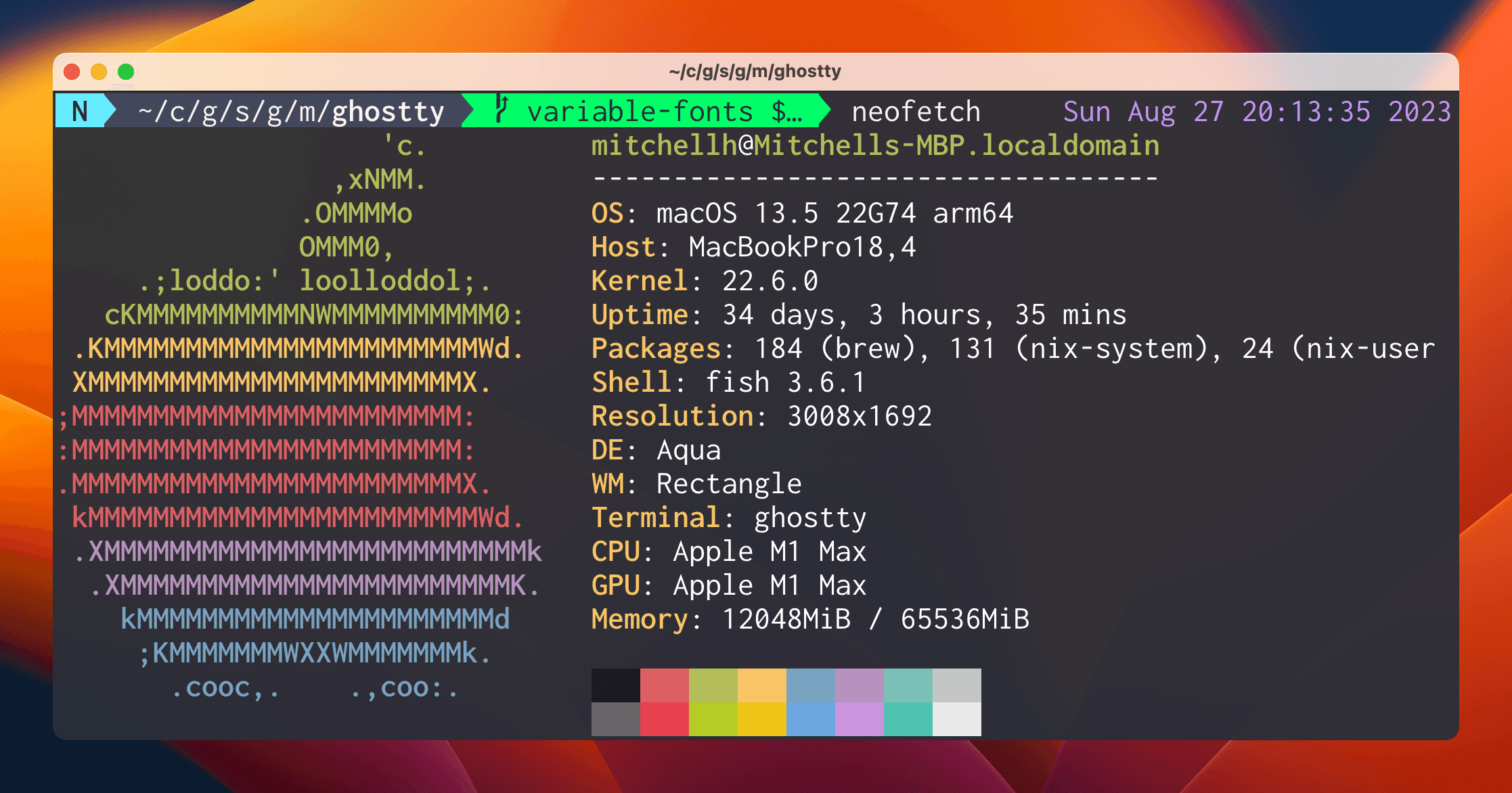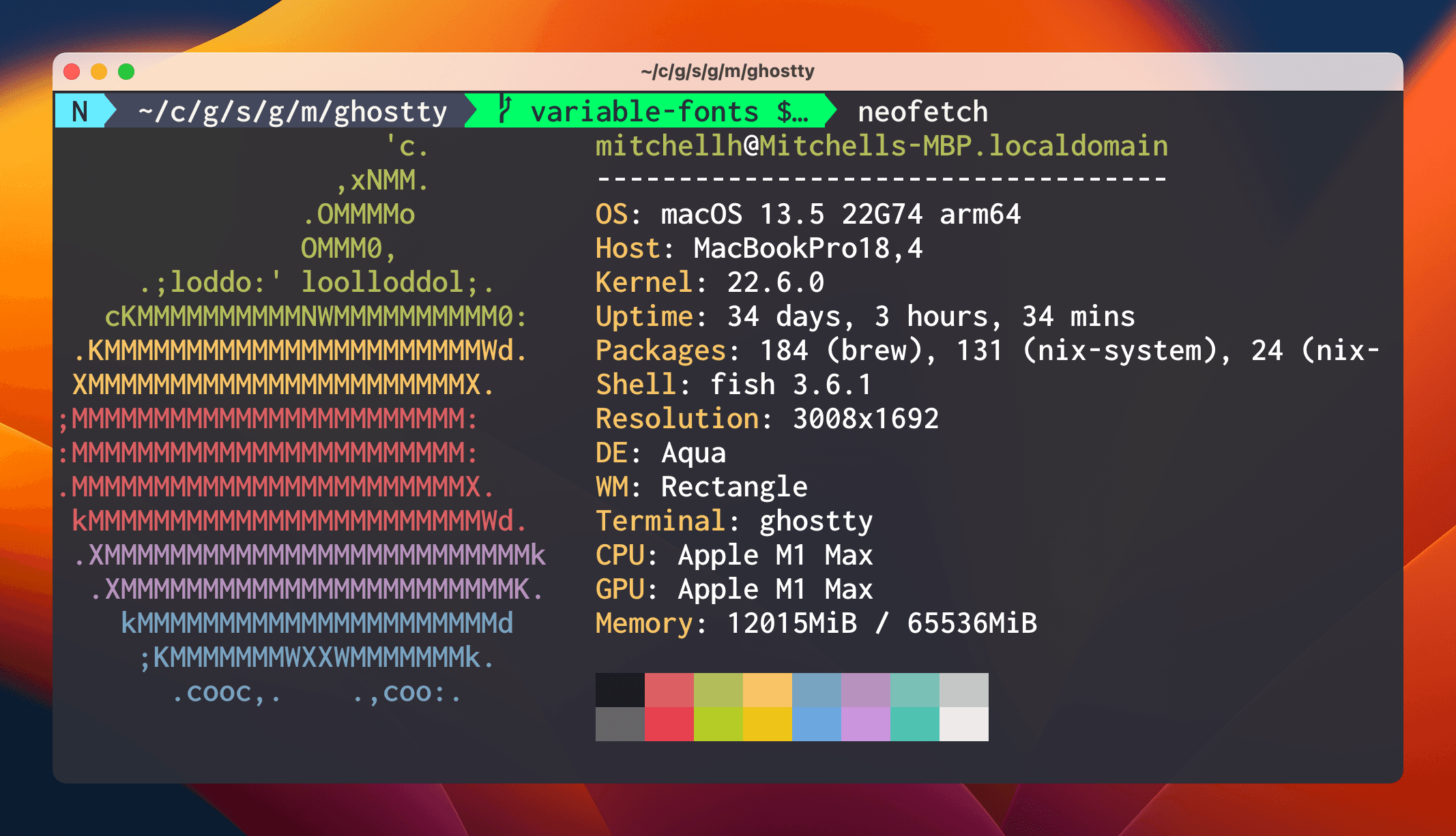Mitchell Hashimoto
Ghostty Devlog 004
Hello! Welcome to the fourth official devlog for Ghostty 👻!
If you missed previous devlogs, or you want to learn more about what Ghostty is, please see the Ghostty page on this website.
Community Updates
Last week, I shared our public Discord server and I also gave a talk on Ghostty and Zig. If you missed either of those, please check it out. I distribute new beta invites through the Discord community. Also, our Discord community has grown to over 600 people. Wow!
Since the last Ghostty devlog, the closed beta has grown from around 30 people to about 100 people. Early in the project each new beta wave would be only a few people, but as Ghostty has become more stable, we've been able to comfortably grow the closed beta by 15 to 20 people per wave now. I'm taking this as a great sign!
Pretty GUIs
Before diving into the deep end of terminal internals and archaic technologies, let's talk about GUI improvements and look at some eye candy. If you're looking for deeply technical content, later sections really go into some weeds.
The native GUIs on both macOS and Linux have made some big leaps. On Linux, Ghostty now has a headerbar menu, wide tabs (configurable), an About window, and more. Side by side with Gnome Terminal and other GTK-based terminals, Ghostty fits right in:

Also for Linux, we now have multiple beta testers using Wayland via Sway, Hyprland, and other compositors. We fixed a number of issues and Ghostty now works great with Wayland.
On macOS, we added a window-theme setting so you can permanently
set your Ghostty instance in dark or light mode instead of just following
your system. I personally run macOS in light mode but my terminal is
perpetually dark so I can force it dark. We also made it so unfocused
splits are faded (this can be configured). It all looks beautiful:

One of Ghostty's stated goals is to have native experiences that make it feel like Ghostty was purpose-built for the platform you're on. We take GUI improvements very seriously and ensure Ghostty follows idiomatic designs for the platform it is running on. The improvements above showcase our progress on these ideals.
We Found a Vim Bug! And Other Naughty Programs.
For most of its life, Ghostty has been advertising itself as
TERM=xterm-ghostty. The xterm- prefix is because a lot of naughty
programs do string matching on TERM to determine if a terminal supports
some set of functionality. This is wrong and very naughty, do not do this!
The correct approach is to query the terminfo database.
Terminfo is an extremely interesting (primarily because it is so cursed)
topic on its own. I hope to write a dedicated blog post on terminfo one
day. This devlog will not go into detail about terminfo. If you care to
get a glimpse of this archaic beast, run infocmp in your terminal.
For the last month, we've been trying to rid ourselves of the xterm- prefix
and simply become TERM=ghostty. In the process, we've found a lot of bugs
with our own terminfo database as well as upstream issues. We've been fixing
both as we go.
Most recently, we've become blocked by a vim bug. Vim 9.0 supports Kitty Keyboard Protocol, but hardcodes the list of terminals that support it and doesn't properly respect the terminfo database. This is a bug, and a Ghostty community member amazingly has opened a pull request to fix it. This issue does not affect Neovim.
Vim is just a little bit important1, so until that bug is fixed and downstream
distributions are broadly updated, we've unfortunately had to revert to
being TERM=xterm-ghostty. Still, I'm proud of the progress we made and
I'm optimistic we can yield our xterm shackles soon.
We found other upstream bugs, and I'm proud that Ghostty community have been
not only reporting issues, but also providing fixes. Tim made a PR to
the popular Go library tcell
to fix a particularly bad issue. This is an important library since it is
used by popular TUI applications such as lazygit, lazydocker, etc. Without
this fix, all of those programs spew garbage unless you run them explicitly
with TERM=xterm-256color. I hope this can be accepted soon!
None of these bugs or fixes are Ghostty specific, and all should serve to make programs more robust in the face of all unfamiliar terminal emulators.
This work was primarily driven by Tim Culverhouse and I'm deeply appreciative of everything he's done here.
XTGETTCAP (#563)
One of the big problems with terminfo is that it relies on a local file that the running program must inspect. This means that if you SSH into a remote host and the remote host doesn't have your terminal's terminfo, the program won't be able to determine what your terminal is capable of and may behave incorrectly or suboptimally.
XTGETTCAP is a feature of terminals that allows querying the terminfo
database for a terminal through VT escape sequences rather than reading
a local file. This has a couple benefits: programs don't need to know how
to parse the binary format or lookup the file path, and programs can query
terminfo even if they're running remotely.
XTGETTCAP looks like this:
# Query for stylized underline support (key "Smulx")
ESC P + q 536D756C78 ESC \
# Response from the terminal (Smulx=\E[4:%p1%dm)
ESC P 1 + r 536D756C78=5C45343A25703125646D ESC \
Totally obvious, yeah? Really its not too bad. A program sends the text
ESC P + q <key> ESC \ where <key> is a hex-encoded string. In the
example above, we hex-encoded "Smulx". And the response has the key and value
of that terminfo entry, also hex-encoded.
A particularly cool thing about our implementation is that we used Zig's comptime capability to generate all possible requests and responses at compile-time. This is generated from the same source file that generates our actual terminfo file, so our terminfo and XTGETTCAP are always perfectly in sync.
XTGETTCAP performance doesn't really matter at all, but our XTGETTCAP implementation is stupid fast because it is a compile-time optimized lookup table. We don't have to perform any allocations, string formatting, etc. We do a simple lookup, find a stable character pointer, and write that directly to the pty. Very cool.
Take a look at the Zig snippet that generates this. I love Zig comptime.
Variable Fonts (#345)
Most fonts supply a set of fixed styles, such as "Bold", "Heavy", "Medium", "Italic", etc. Variable fonts on the other hand provide a single font face that makes various axes such as weight, slant, etc. configurable with a continuous value in some range. Ghostty now supports variable fonts and configuring variation axes.
First, let's take a look at what a variable font looks like. Inconsolata has a variable font version and you can see the video below where I can finely control character width and weight.
Here is what Ghostty looks like by default with Inconsolata, with no font variation axes set:

And here is a configuration where we slightly modify the weight. The difference is subtle but you can see it. The configuration first followed by a screenshot.
font-family = Inconsolata
font-variation-bold = wght=500

Why wght above and not weight? The key of the variation is determined
by the font and font variations must be four characters. These aren't
standardized so we can't safely convert weight to wght. The Ghostty
config uses the literal variation key and users can use any font inspection
program (such as FontDrop) to determine valid
keys.
Support for variable fonts is relatively rare amongst terminal emulators, so I'm proud we support this (and cross-platform!). These types of features really let you fine tune your terminal to be exactly how you want it and make it feel just right.
Fin
Thanks again to our most recent round of beta testers. Each round always brings in really incredible people who have certain specialized depths of knowledge or exercise the terminal in new, unique ways to find issues.
If you want to keep up to date, follow me on Twitter or Mastodon (links in footer). This blog also has an RSS feed.
Boo. 👻
Footnotes
-
Rest in peace Bram Moolenaar and thank you for everything you gave to us. ↩